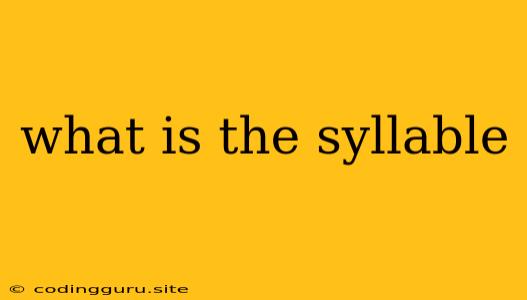What is a Syllable?
Have you ever wondered why some words are easy to pronounce while others seem to trip your tongue? The answer lies in syllables, the building blocks of spoken language. But what exactly is a syllable?
In simple terms, a syllable is a unit of pronunciation that consists of a single vowel sound, with or without surrounding consonants. Think of it as a "beat" in a word. Each syllable is a single, distinct sound that we make when we speak.
How Many Syllables Does a Word Have?
You can easily determine the number of syllables in a word by counting the number of vowel sounds. For instance:
- Cat has one vowel sound ("a") and therefore one syllable.
- Happy has two vowel sounds ("a" and "i") and therefore two syllables.
- Elephant has three vowel sounds ("e", "e", and "a") and therefore three syllables.
Understanding Syllable Structure
Syllables usually follow a simple structure:
- Onset: This is the optional consonant sound at the beginning of the syllable. For example, in the word "cat," the "c" sound is the onset.
- Nucleus: This is the vowel sound at the heart of the syllable. In "cat," the "a" sound is the nucleus.
- Coda: This is the optional consonant sound at the end of the syllable. In "cat," the "t" sound is the coda.
Not all syllables have an onset or a coda. For example, the word "I" only has a nucleus, the vowel sound "i."
Why Are Syllables Important?
Understanding syllables is crucial for a number of reasons:
- Pronunciation: Syllable structure helps us understand how to pronounce words correctly.
- Spelling: Knowing the syllables in a word can help us spell it correctly.
- Reading: Understanding syllables makes reading easier and faster, particularly for new readers.
- Poetry: Syllables are a key element in poetry, influencing rhythm and rhyme.
Syllables in Different Languages
The way syllables are structured and pronounced can vary across different languages. For example, English has a relatively simple syllable structure compared to languages like Japanese or Mandarin Chinese.
Tips for Syllable Awareness
Here are some tips to improve your syllable awareness:
- Clap along: When you read a word, clap for each syllable.
- Break it down: Separate a word into its individual syllables.
- Practice pronunciation: Pay attention to the vowel sounds in each syllable.
- Play syllable games: There are many fun games that can help children learn about syllables.
Conclusion
Syllables are the fundamental units of spoken language, providing structure and rhythm to our words. By understanding how syllables work, we can improve our pronunciation, spelling, reading, and even our appreciation of poetry.
